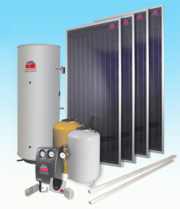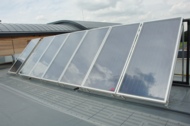Solar thermal as a source of renewable energy

The key to the success of a solar-thermal installation is all in the sizing — just one of the problems which is taken away from the designer by using an Andrews SOLARflo system.
In a building with the right energy balance, using solar energy to produce domestic hot water can meet the 10% renewable requirement. Yan Evans gives practical advice how to get the best from this technology.Directives, legislation, building regulations, planning consent and environmental policies are driving end users, architects, design engineers and installers to seriously consider the use of low carbon and renewable solutions in residential, commercial and industrial applications. Local authorities in a number of regions of the UK have introduced planning consent requirements insisting that at least 10% of the energy required for a new build property with floor space of 1000 m2 and above is derived from renewable sources. Increasing pressure is being applied on all areas of the building services industry from architects through to installers to deliver solutions that minimise emissions and result in properties with the lowest possible carbon footprint — and solar thermal solutions have an important role to play. Solar thermal solutions harness energy from the Sun to heat hot water. Using solar energy in this manner is a concept that has been available in a variety of guises since the mid 1970s. Roof-mounted solar collectors with high transmission and absorption efficiencies capture energy from incident solar irradiation, passing the heat into a transfer fluid — usually a mixture of water and glycol to prevent freezing when the outdoor temperature is low. With indirect solar thermal solutions (more common in commercial applications), the heat-transfer fluid is pumped through a coil located in the lower section of an unvented indirect cylinder to heat the stored water. Key to success The key to the success of a solar-thermal installation is all in the sizing, and the methodology adopted varies depending on the type of collector. Two types of collector are commonly used in the UK — glazed flat-plate collectors and evacuated-tube collectors. Both use solar glass with a low thermal-expansion coefficient and high light-transmission efficiency, typically around 91%. Equally, both types offer high energy-absorption efficiencies of around 95% and low emissions (less than 5%). The construction of an evacuated-tube collector is such that the vacuum which is created during manufacturing acts as an insulator. The collector is therefore far less susceptible to losses via convection during periods of low ambient-air temperature and wind. The result is that over a full year the thermal efficiency of an evacuated-tube collector offers an improvement over glazed flat-plate collectors for similar absorber surface areas. A well designed solar-thermal system for the UK climate should aim for a solar fraction of around 50 to 60% (the percentage of the domestic hot water met by the solar-thermal system), with the balance provided by conventional gas-fired boilers or water heaters.
 |
Every square metre of glazed flat-plate collector can serve about 50 litres of stored hot water — and heat it entirely in the summer. |
During the warmer summer months, the solar fraction could be as high as 100% and in the winter as low as around 20%. To achieve an average of 50% from the solar-thermal system over a full year, the volume of stored water must correspond to the daily hot-water demand. The hot-water load will drive the selection of the stored water, which in turn determines the size of the collector array to be installed. However there are exceptions to this rule — available roof space (which ideally needs to be facing due south with an angle of inclination from the horizontal of 30 to 45°), plant-room space and capital cost.
Optimum system As a rule-of-thumb for glazed flat-plate collectors around 50 litres of stored water per square metre of solar-collector array would offer an optimum system. This is the minimum volume of water required to prevent the collector from stagnating during periods of high available solar irradiation. With higher thermal efficiencies and a larger volume of heat-transfer fluid, evacuated-tube collectors require a minimum of around 100 litres of stored water per square metre. Solar-thermal solutions can be used with direct-fired water heaters (cold water inlet pre-heat) and with commercial boilers via a twin-coil cylinder. For either system the sizing methodology and expected carbon emissions is comparable. A well designed solar-thermal system delivering a solar fraction of around 50% would reduce carbon-dioxide emissions by about 100 kg/m2 of collector array per annum when compared with natural gas, which in the UK has a carbon-dioxide emission factor of 0.193 kg/kWh (source: DTI).
10% target But how much does a well designed solar-thermal system contribute to the target of 10% of the energy derived from renewable sources? The answer depends on how the energy use of a building is made up, which will vary for different buildings and occupancy levels. The energy use is made up of electricity consumption (pumps, lighting, IT etc.) and gas/oil/LPG consumption for space heating and producing hot water. If the solar thermal system is sized to satisfy 50% of the domestic hot water load, and this load equates to 20% of the building’s energy consumption, then the ‘10% renewables target’ can be achieved. However the balance between domestic-hot-water load and other energy consumers within the building may be such that other low-carbon and renewable technologies such as CHP and ground- source heat pumps may have to be installed to achieve the required reduction in carbon emissions. Caution should be applied when considering a combination of different types of technologies, as not all will work in harmony. Solar-thermal solutions have a huge contribution to make towards delivering a low carbon footprint. It is one of the most mature of the renewable technologies available and relatively simple to integrate into a building’s hot-water system. However, it is the sizing and selection of the optimum solar thermal system to match the hot water demand profile that will deliver true carbon-emission savings.
Yan Evans is technical director with Baxi Commercial Heating.
Related links:




